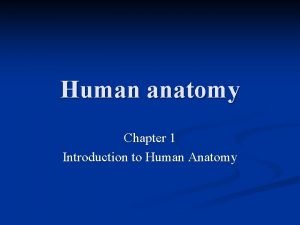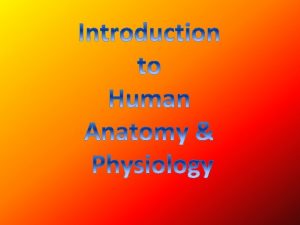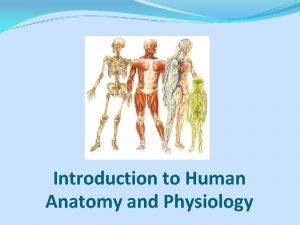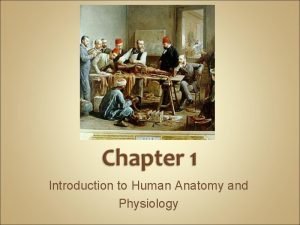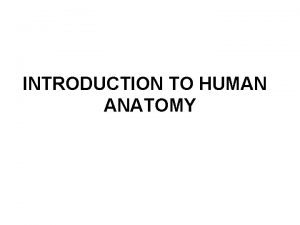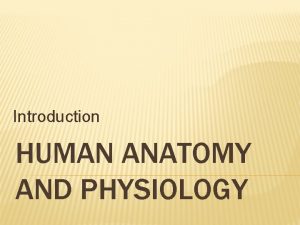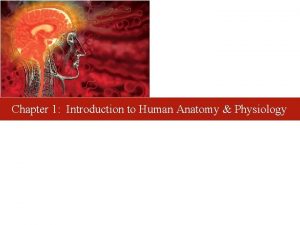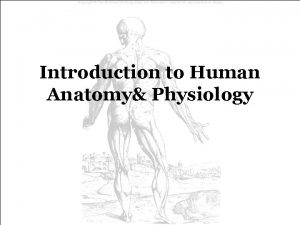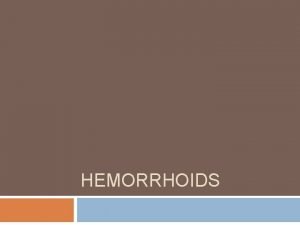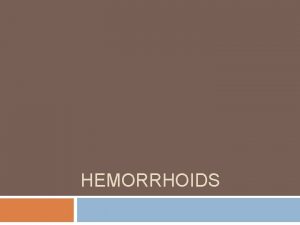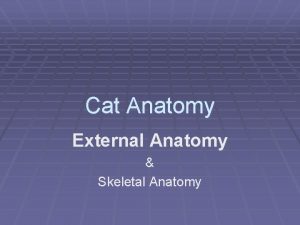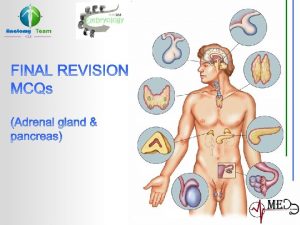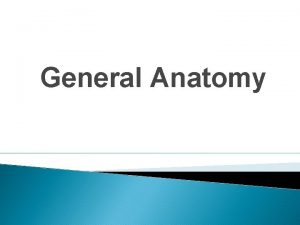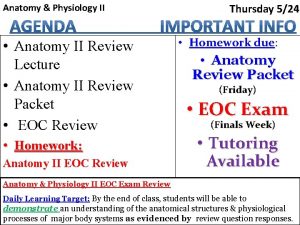Introduction to Human Anatomy The human anatomy is








































- Slides: 40

Introduction to Human Anatomy

The human anatomy is the science of studying the various structures of the human body. n The human body consists of various types of specialized cells and a varying amount of intercellular substance. n

n The cell is the basic unit of the human body. Most types of cells tend to occur in groups similar both in appearance and in function. Such organized groups of cells are known as tissues.

n Various types of tissues form more complex anatomical functional units known as organs which in turns form system.

Studying the structure of the cells is called cytology. n Studying the structure at tissue level is called histology. n Studying the structure of the body systems is called systemic anatomy. n

Human anatomy is studied by 2 methods: n 1. Regional or topographical anatomy: n The structures of the human body are studied as they lie in the body in relation to each other in different regions. The regions are n 1. Head 2. Neck n 3. Trunk n Chest Abdomen Pelvis n 4. Limbs n upper limb n

n 2. Systematic anatomy: n In which the various structures of the body are studied as individual systems. n These systems are:

1 - Osteology: The bony system or skeleton. 2 - Syndesmology: Articular systems or joints. 3 - Myology: Muscular system. 4 - Angiology: Heart, blood vessels, lymph vessels and lymph nodes. 5 - Neurology: Nervous system and organs of sense. 6 - Splanchnology of viscera: a) Respiratory system. b) Digestive system. c) Urogenital system. d) Ductuless or endocrine glands.

The anatomical position: The person is oriented in an erect standing position, with eyes and head looking forwards, the arms close to the sides,

palms of the hands facing forward with fingers extended, and feet forward and perpendicular to the body with the heels are together.

The anatomical planes ☺The median plane is an imaginary vertical plane passing through the center of the body, dividing it into equal right and left halves ☺Sagittal (paramedian) plane is any plane parallel to the median plane.

☺Coronal plane is any vertical plane at right angle to the median plane or sagittal plane. It divides the body into anterior and posterior parts. ☺Horizontal or transverse plane is any plane at right angle to both the median and coronal planes. It divides the body into upper and lower parts.

median Planes Sagittal Coronal Horizontal

Median: any structure lying in the median plane. ☺The terms anterior and posterior are used to indicate the front or back of the body, respectively.

Anterior (ventral): any structure nearer to the front is said to be anterior. Posterior (dorsal): any structure nearer to the back of the body.

N. B. In describing the hand, the terms palmar and dorsal surfaces are used in place of anterior and posterior, and in describing the foot, the terms plantar and dorsal surfaces are used instead of lower and upper surfaces. n

The terms proximal and distal describe the relative distances from the roots of the limbs; for example, the forearm is proximal to the hand is distal to the forearm.

Proximal: any structure nearer to the roots of the limbs (trunk). Distal: any structure far away from the roots of the limbs (trunk).

☺The terms superficial and deep denote the relative distances of structures from the surface of the body. Superficial: means nearer to the surface (skin) of the body. Deep: means away from the surface (skin) of the body.

☺The terms superior and inferior refer to levels relatively high or low with reference to the upper and lower ends of the body.

Medial: A structure situated nearer to the median plane of the body than another is said to be medial to the other.

Lateral: A structure that lies farther away from the median plane than another is said to be lateral to the other.

Terms related to movement:

n ☺Flexion Bending anteriorly. In limbs, it is folding the limb. n Extension: Bendingposteriorly. In limbs, it is straightening the limb.

☺Abduction of a limb is the movement away from the midline of the body in the coronal plane. ☺Adduction of a limb is the movement toward the body in the coronal plane

☺Circumduction is the combination in sequence of the movements of flexion, extension, abduction, and adduction.

n SOME BASIC ANATOMICAL STRUCTURES Skin

Skin n The skin covers the body surface. It protects the deeper structures, and plays an important rule in regulation of body temperature.

n It consists of a deep layer of vascular fibrous tissue termed dermis and a superficial avascular layer, which is formed of many layers of cells, termed epidermis. n.

n Beneath the dermis there are certain organs of special functions namely the sweat and sebaceous glands and the hair follicles.

Fascia The fascia of the body is divided into two types, the superficial and the deep. They lie between the skin and the underlying muscles and bones.

n The superficial fascia, It is a fibro fatty layer underneath the skin. It forms a network of fibrous tissue, the intersects of which are filled with fat.

n It is dense in the scalp, back of the neck, palms of the hands and soles of the feet. n It is very thin over the dorsal aspects of the hands, feet, sides of neck and face.

n It is most distinct at the lower part of the anterior abdominal wall, limbs and perineum.

n It facilitates the movements of the skin retains the warmth of the body and gives the body its contour. n The thickness of the superficial fascia depends on the quality of fat. It varies from body to body and from part of the body to another.

Contents of superficial fascia: n There are many structures passing through it in their way to or from the skin : n 1. Blood vessels. 2. Lymph vessels. n 3. Lymph nodes. 4. Nerves. n 5. Glands of the skin 6. Roots of hairs. n 7. Muscles in certain part of the body like platysma. n

The deep fascia: n It is a thin dense membrane located deep to the superficial fascia. It is loosely attached to the superficial fascia.

The deep fascia: n It is inelastic, forming sheath for the muscles and preserving the contour of the limb.

The deep fascia sends various intermuscular septa from its deep surface to connect it to the bone. These septa divide the limb into different groups of muscles.

It is thickened in the palm of the hand sole of the foot. n It is absent in the abdomen allowing it to change its volume during respiration. n
 Chapter 1 introduction to human anatomy and physiology
Chapter 1 introduction to human anatomy and physiology Anterior posterior distal proximal
Anterior posterior distal proximal Hình ảnh bộ gõ cơ thể búng tay
Hình ảnh bộ gõ cơ thể búng tay Lp html
Lp html Bổ thể
Bổ thể Tỉ lệ cơ thể trẻ em
Tỉ lệ cơ thể trẻ em Chó sói
Chó sói Glasgow thang điểm
Glasgow thang điểm Chúa sống lại
Chúa sống lại Môn thể thao bắt đầu bằng từ đua
Môn thể thao bắt đầu bằng từ đua Thế nào là hệ số cao nhất
Thế nào là hệ số cao nhất Các châu lục và đại dương trên thế giới
Các châu lục và đại dương trên thế giới Công của trọng lực
Công của trọng lực Trời xanh đây là của chúng ta thể thơ
Trời xanh đây là của chúng ta thể thơ Mật thư anh em như thể tay chân
Mật thư anh em như thể tay chân 101012 bằng
101012 bằng Phản ứng thế ankan
Phản ứng thế ankan Các châu lục và đại dương trên thế giới
Các châu lục và đại dương trên thế giới Thể thơ truyền thống
Thể thơ truyền thống Quá trình desamine hóa có thể tạo ra
Quá trình desamine hóa có thể tạo ra Một số thể thơ truyền thống
Một số thể thơ truyền thống Cái miệng bé xinh thế chỉ nói điều hay thôi
Cái miệng bé xinh thế chỉ nói điều hay thôi Vẽ hình chiếu vuông góc của vật thể sau
Vẽ hình chiếu vuông góc của vật thể sau Thế nào là sự mỏi cơ
Thế nào là sự mỏi cơ đặc điểm cơ thể của người tối cổ
đặc điểm cơ thể của người tối cổ V cc cc
V cc cc Vẽ hình chiếu đứng bằng cạnh của vật thể
Vẽ hình chiếu đứng bằng cạnh của vật thể Tia chieu sa te
Tia chieu sa te Thẻ vin
Thẻ vin đại từ thay thế
đại từ thay thế điện thế nghỉ
điện thế nghỉ Tư thế ngồi viết
Tư thế ngồi viết Diễn thế sinh thái là
Diễn thế sinh thái là Dot
Dot Thế nào là số nguyên tố
Thế nào là số nguyên tố Tư thế ngồi viết
Tư thế ngồi viết Lời thề hippocrates
Lời thề hippocrates Thiếu nhi thế giới liên hoan
Thiếu nhi thế giới liên hoan ưu thế lai là gì
ưu thế lai là gì Hổ đẻ mỗi lứa mấy con
Hổ đẻ mỗi lứa mấy con Khi nào hổ con có thể sống độc lập
Khi nào hổ con có thể sống độc lập









































